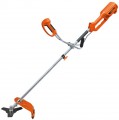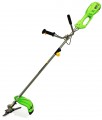Cutting width
The capture width provided by the unit, in other words, the width of the strip of land cultivated in one pass. In fact, this size corresponds to the width of the working nozzle.
The large working width is useful when processing large open spaces, as it allows you to finish the job in a small number of passes. On the other hand, for hard-to-reach places, relatively narrow tools are better suited, able to go where a wider unit will not fit. In addition, the width of the tool directly affects the weight and price.
In general, it makes sense to compare in terms of working width only units of the same type (see above). However, it is worth noting here that trimmers do not differ so much from each other — most models capture from 25 to 45 cm (and a wide processing band is provided by moving the nozzle from side to side). As for the other types, in the most modest models the capture width
does not exceed 40 cm, in the heaviest and most powerful it can be
56 – 60 cm or even
more(in mini tractors — up to 1.5 m).
Trimmer blade width
The width (diameter) of the trimmer knife characterizes the size of the paddle knife (or saw blade). Such a nozzle has a smaller capture width than a fishing line, however, it allows you to mow more dense thickets, including shrubs.
Line diameter
The diameter of the fishing line supplied with the trimmer (more precisely, with a reel attachment, see "Tips").
In modern models, this parameter can be from 1 to 4 mm. At the same time, a thicker fishing line handles better with dense thickets, but it works rougher, the treated lawn is not particularly even, and for the effective operation of such a nozzle, a fairly powerful engine is needed. On the other hand, a fine line provides a clean and neat cut, but is not suitable for heavy vegetation and large stems. Thus, thick fishing line is usually equipped with powerful units designed for "launched" lawns with an abundance of thick stems. Thin, on the other hand, is found mainly in low-power electric trimmers with a lower engine location, designed for neat lawns with regularly cut grass.
We also recall that many trimmers have the ability to replace the standard reel with another one that differs in line thickness.
Soft start
The presence of a
soft start system in the lawn mower engine.
The design features of electric motors are such that when power is applied directly, the start occurs very abruptly — both in a mechanical and electrical sense. Firstly, the engine itself spins up in a jerk, in a very short time, which increases the wear of its parts. Secondly, at the moment of start-up, there is a sharp jump in current strength, which creates significant loads on the power grid (or the batteries of the unit). The soft start system eliminates these phenomena: it limits the starting current, allowing the motor to accelerate smoothly and preventing voltage surges.
On the other hand, additional electronic circuits affect the cost, sometimes quite significantly. So there are few models with this feature nowadays, and you should pay attention to them mainly in cases where the mentioned advantages are of fundamental importance — for example, if the device is purchased for a house with weak wiring that does not tolerate voltage surges.

